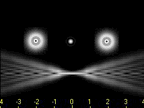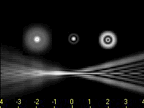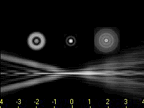

The Official Publication of the Bucks-Mont Astronomical Association, Inc
____________________________________________________________________________________________________________________________________
©2001 BMAA, Inc
BMAA Astronomy Day 2001
A rainy Saturday greeted all the BMAA volunteers at this year's Astronomy Day on May 26, at Goodnoe's Restaurant in Newtown. We set displays up on the porch and in a tent, and quite a few people stopped by to talk to us, but there were no telescopes or viewing because of the weather. David Fair, Outreach Coordinator of NASA's Goddard Space Flight Center, spoke at 2:00p on "Living and Working In Space", to a small but enthusiastic crowd in the tent. After packing everything away at 5:30p, about a dozen of us enjoyed BMAA camaraderie around an unhurried Goodnoe's meal.
Linda van der Spek, who coordinated the event, sincerely thanks all the members who helped this year.
__________________________________________________________________________________________
TVASEC News
Recently, there has been renewed interest within the BMAA membership in the observation (TVASEC) sites we have in partnership with the Bucks County Department of Parks and Recreation. This is an ongoing work-in-progress and it was intended by this editor (TVASEC chair) to print an update on the sites in this issue of the CONSTELLATION. However, over the weekend of June 2-3 there was a lot of e-mail traffic regarding the sites (WAY too much to print in the Forum here), and since TVASEC is on the agenda for the June 6 meeting, this editor will reserve comment until then in the public setting with the membership. TVASEC issues will be published in future editions of this newsletter and on our website as needed. It should be noted that the BMAA newsgroup is available on-line to any and all members in good standing, as is the Forum in this newsletter.
- Scott Petersen, editor
__________________________________________________________________________________________
Stew Leabman is Subscriptions Chairman, 215/794-1360 or videodaze@att.net.
By contacting him, as a BMAA member, you can obtain a discount subscription
(new or renewal) to Astronomy or Sky and Telescope magazines.
__________________________________________________________________________________________
The next BMAA General Meeting is scheduled for Wednesday, June 6 at 8:00p
held at Peace Valley Nature Center, Doylestown
_________________________________________________________________________________________________________________________
BMAA MESSAGELINE - 215/579-9973
Contact BMAA -- bmaa@ixc.net
___________________________________________________________________________________________________________
The CONSTELLATION is the official publication of the Bucks-Mont Astronomical Association, Inc, a 501(c)3 non-profit organization incorporated in the Commonwealth of Pennsylvania and exists for the exchange of ideas, news, information and publicity among the BMAA membership, as well as the amateur astronomy community at large. The views expressed are not necessarily those of BMAA, but of the contributors and are edited to fit within the format and confines of the publication. Unsolicited articles relevant to astronomy are welcomed and may be submitted to the Editor.
Reprints of articles, or complete issues of the CONSTELLATION, are available by contacting the Editor at the address listed below, and portions may be reproduced without permission, provided explicit acknowledgement is made and a copy of that publication is sent to the Editor. The contents of this publication, and its format (published hard copy or electronic) are copyright ©2001 BMAA, Inc.
In an effort to transmit the CONSTELLATION electronically to the membership of BMAA, please provide a current e-dress to the Editor. Abbreviated issues are available on the web site, but complete editions will be e-mailed to members in good standing.
Submission deadline for articles is the 15th of the month prior to publication.
___________________________________________________________________________________________________________
Bucks-Mont Astronomical Association, Inc
2001 Calendar of Events
StarWatch Chairman: Antoine Pharamond, 215/412-9291 apharamond@adelphia.net
Information Line - 215/579-9973
___________________________________________________________________________________________________________
Meet the Aberrators IV: Spherical Aberration
- by John C Deitz
Spherical Aberration: Occurs when light from different heights comes to a different focus along the optical axis.

Newton would describe image formation to take place as shown in Illustration 1 (except that the lens shown here is an achromat, something Newton felt could not be achieved). Light from a distant source arrives as parallel rays at various heights (distances from the optical axis), in a perfect system, to a common focus at a single infinitely small point.

Illustration 2
shows what happens in the presence of spherical aberration. Different ray heights (h) have different focal lengths. In this example the outer parts of the lens have a shorter focal length than the inner part. This aberration is seen over the entire field of view.If a computer program is used to design the "perfect" objective (one free of all aberrations, at least on axis) the program will yield a single point (used to represent an infinitely small point) to indicate focus. On each side of focus one would expect to find a uniformly light disc of light. However, this is NOT what we see in our telescopes!
Both Newtons' concept and the raytrace computer programs are based on a geometric theory that treats light as rays. However, what we see is a result of light propagation as a wave- a central bright disc (the Airy disc) that contains most of the light (in a perfect system) surrounded by rings of light that are less and less bright.
 Illustration 3
Illustration 3
Illustration 3
depicts what we see, based on treating light as a wave. Consider the cross-section of the beam very close to focus, with the numbers (-4 to 0 to 4) being the distance from focus measured in wavelengths of light. In the area just a little on each side of zero focus is very good, with most of the energy in the central disc with a very faint "halo" surrounding the disc. Above the slice are images of a star as seen through the eyepiece at 2 wavelengths short of focus, at focus, and at two wavelengths extrafocal. The infrafocal focal and extra-focal diffraction patterns are identical. Notice the symmetry in the slice. At any distance from focus the patterns inside and outside are identical. This is true with perfect optics!  Illustration 4
Illustration 4
Now examine Illustration 4. Here the wavefront exhibits 1/3 wave overcorrection ("mirror too deep"). The symmetry is broken. More importantly, the disc size at best focus is larger and more light finds its' way into the diffraction ring(s). As the situation worsens the resolution drops. Lord Rayleigh tells us that at 1/4 wave aberration (total) resolution is significantly reduced. For some application (lunar and planetary) most observers want better than this limit.

Illustration 5
shows us what happens with 1/3 wave under-correction AND a 25% central obstruction (as in a Newtonian or Schmidt-Cassegrain). The overall symmetry is reversed relative to Illustration 4 and the disc made larger with more light in the diffraction rings as a result of the obstruction.In examining the out-of-focus star image a moderately powerful eyepiece (10mm) is employed and the infrafocal and extrafocal patterns compared. The focusing mechanism can be marked so as to reach a similar distance inside and outside focus. Probably the most convenient method is to unthread an eyepiece from the barrel, counting the number of turns. Rethread about half way. Now, focus the telescope and lock down the eyepiece with the setscrew. Thread the lens into the barrel a short distance to examine the infrafocal pattern of a moderately bright star. Now thread out an equal distance and examine once again. A departure from symmetry is a departure from perfection!
Keep in mind - 1/8 wave departure at the mirror of a Newtonian results in twice this amount at the focal plane. Additionally, if the surface departure is in a narrow outer area (turned down edge), with the remaining mirror perfect, the performance will suffer much more than if the mirror departs smoothly from perfection. Also, a "dog biscuit" surface - one with many local shallow "ripples", will result in a significantly degraded optic even with very narrow departures from perfection.
 Illustration 6
Illustration 6
Illustration 6
shows Mars with a perfect 8in optic with mild turbulence in the tube (left panel). The right panel is in the same telescope, same tube currents, but with 1/3 wavelength overcorrection and a 25% obstruction.Once again the author has employed ABERRATOR in generating star test images. You should too! Visit the web site - actual images of star tests are available. ABERRATOR 3.0 (BETA) has new features as well.
* * * * * * *
- BMAA member John Deitz produces a monthly technical series for the CONSTELLATION. He can be reached at
johncdeitz@cs.com. [ -ed]______________________________________________________________________________________________________________________
2001 BMAA Officers
President - Ed Murray, 215/493-2843 edward12@erols.com
Vice President - Antoine Pharamond, 215/412-9291 apharamond@adelphia.net
Treasurer - Ed Radomski, 215/822-8312 ejrado@prodigy.net
Secretary - Ken Wieland, 215/362-7228 wieland7@netreach.net
* * * * * * *
2001 BMAA Committees
ASTRONOMY DAY - Linda van der Spek, 215/357-5107 105272.2511@compuserve.com
BULLETIN BOARD - Ed Radomski, 215/822-8312 ejrado@prodigy.net
DARK SKY - Paul Kohler, 215/453-0363 ncc1701@vrinter.net
STARWATCH - Antoine Pharamond, 215/412-9291 apharamond@adelphia.net
STELLA-DELLA-VALLEY* - Ed Radomski, 215/822-8312 ejrado@prodigy.net
SUBSCRIPTIONS - Stew Leabman, 215/794-1360 videodaze@att.net
TELESCOPES - Ed Radomski, 215/822-8312 ejrado@prodigy.net
TRANSIENT PHENOMENA - Alan Pasicznyk, 215/348-2385 apasicznyk@yahoo.com
TVASEC - Scott Petersen, 215/598-8447 petersen@netreach.net
UACNJ - Bernie Kosher, 609/888-0183 bkhere@optonline.net
* Ed Radomski needs a co-chair for SDV-XV
__________________________________________________________________________________________